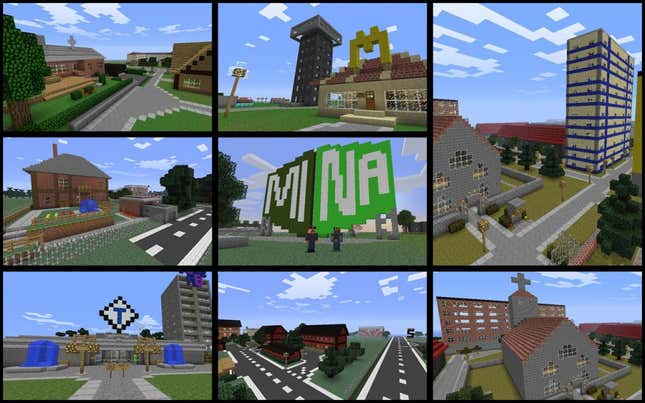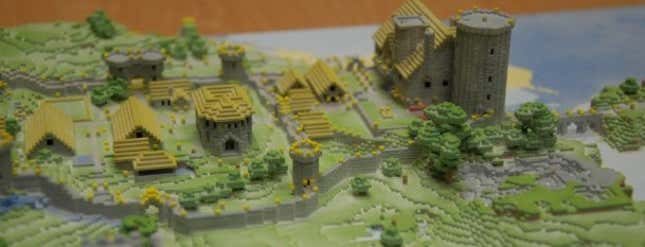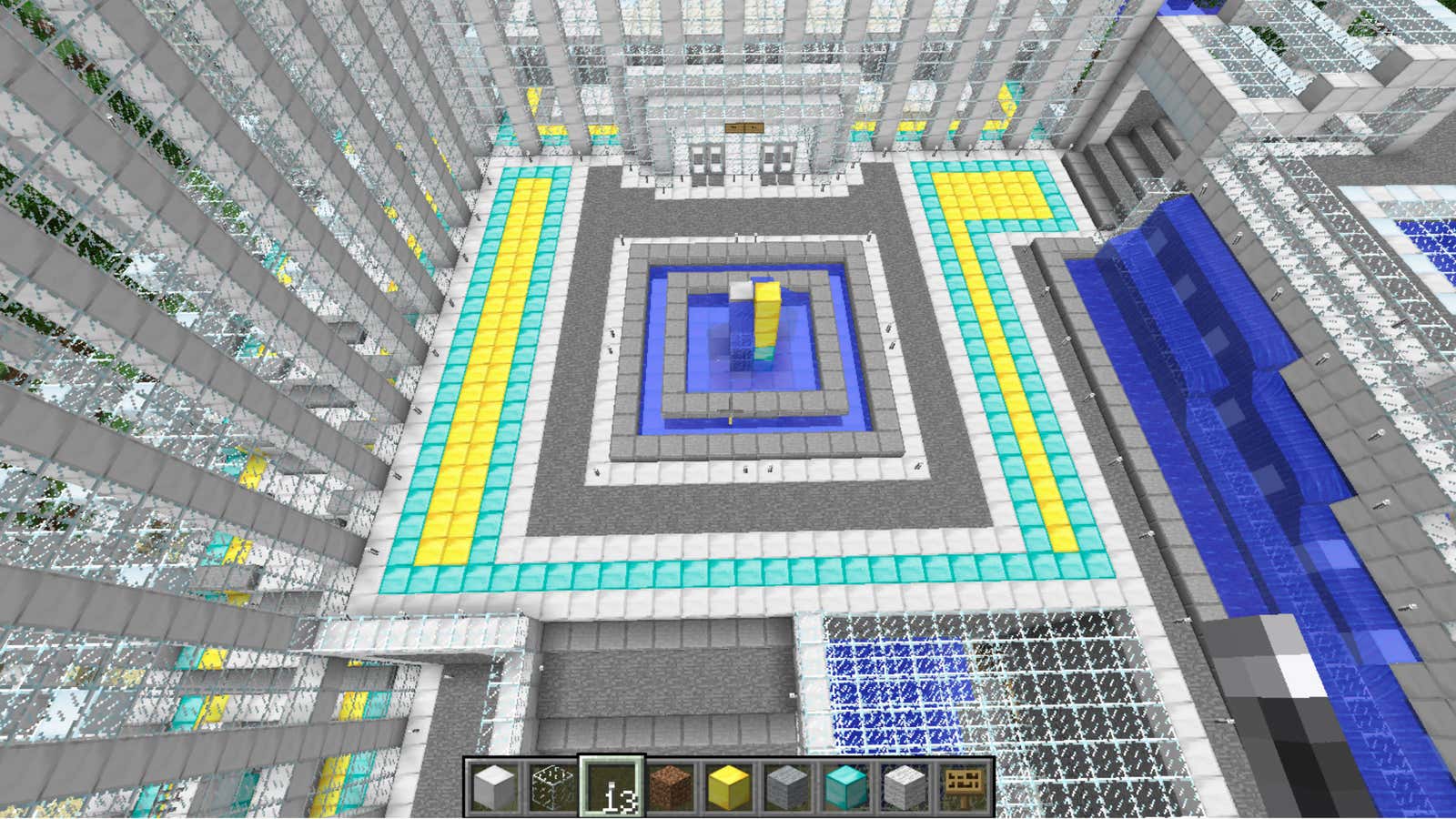On the Boulevard Saint-Michel, near the center of Paris, just off the edge of the Jardin du Luxembourg and just a short stroll from the Sorbonne sits the main campus of the École Nationale Supérieure des Mines de Paris. Known now as Mines ParisTech, this venerable school was set up in 1783 by decree of Louis XVI as the center of education for the finest civil engineers in France. Nearly 230 years later, just an hour’s drive to the east at Disneyland Paris, some of the next generation of the world’s most innovative mining and industrial engineers convened this past weekend—but not for a seminar on metal stress or a lecture on geology. At this gathering, over 4,500 teens, pre-teens and some brave adults swapped server addresses and toted 8-bit pick axes around Minecon, the second annual gathering of hardcore players of Minecraft, possibly the hottest, yet one of the most low-tech games on the market today.
With an estimated 40 million players worldwide, Minecraft has been available for a little over three years, the first of which it spent in rudimentary alpha form with frequent releases from its Swedish creator Markus “Notch” Persson, spreading mainly by word of mouth. Minecraft got its full release on major gaming platforms this time last year. As of mid-November, Mojang, Persson’s game studio, reported it had sold over 8 million copies of the game for the PC alone, with another three million downloads on iOS, Android, and purchases for XBox 360. In short, this scrappy little game in which players dig, build and fly their way through chunky, late 1980s block graphic scenery, dodging bad guys knowns as Creepers and stepping over digital sheep, has pushed its way into the big time without a major licensed character, a blaze of bullets, or the voice of John Madden. The game’s open, often cooperative play, peer-built environments and simplicity has drawn an army of dedicated players who often spend days tunneling, hammering and building, just for the pleasure of making.
Move over, Dubai and Shanghai
In short, the game is a simple “sandbox,” or open world, designed to allow layers to spawn and move about in its 3D, isometric environment. Players dig and build carefully sculpted structures and spaces and gather items like food or tools, interacting or avoiding mobs, or characters, along the way. While Minecraft can be played in traditional survival (gather, create, stay alive), adventure (wander and interact) and hardcore (stay alive or lose everything) modes, the fourth mode, known as the creative mode of Minecraft, where multiple players build together freely, can be the most intriguing. Creative mode is where the interesting, complex and increasingly grandiose creations get built or “crafted” using available resources and tools like the aforementioned pickaxe. Players can build houses, castles and caverns, but also edifices of Pyonyang-scale immensity and absurdity, like sky-high apartment towers, huge working beatboxes, recreations of favorite buildings in painful detail or giant abandoned strip malls.
But clever Minecrafters haven’t stopped with oddball buildings. Numerous solo and team efforts have constructed not only ingenious Rube Goldberg machines, but also mechanical computers based on a schematic in an MIT textbook that can do basic functions and calculations, for example. Early introduction of mechanical levers, circuits, and more recently a modification to add pistons to the game have encouraged players to build increasingly byzantine machines using the most basic of materials. Recent modifications and updates to the game, and unofficial variations created by expert players, such as Tekkit and ComputerCraft, take game functionality to a new level with industrial machines and programmable in-game computers that aren’t for entertainment as much as necessary elements to feed Minecrafters’ growing appetite for engineering. Where a weekend electronics enthusiasts or desktop manufacturing fan might run down to a Radio Shack to grab some extra circuitry for an electronics project, Minecrafters are working in cross-country or sometimes multi-country teams to build energy production systems, massive water projects or underground house-making factories in the game—partly as status symbols among other Minecrafters, and partly to push the boundaries of their own skill and the game’s capabilities.
An 8-bit tool for humanity
This phenomenon of bright young minds exploring engineering through games hasn’t gone unnoticed by experts in two important fields: international development and education. At the beginning of September, Mojang announced a project in cooperation with the UN Habitat called Block by Block, which will engage Minecraft players in an effort to redesign 300 different public spaces over the next three years in locations such as Nairobi’s Kibera slum. This is a follow up to Mojang’s Mina Kvarter (My Block), which in 2011 collaborated with Svensk Byggtjänst (Swedish Building Center) to help local residents visualize improvements to their neighborhoods using models constructed by Minecraft players.

Teachers are looking at Minecraft as a way to fuel self-learning and exploration in the classroom, from elementary school to higher levels. Mojang is also working with a group called MinecraftEDU to consolidate educational purchases and offer training to schools. Driven by teachers in the US and Finland, MinecraftEdu is taking a page from expert players and developing its own educational program to work with the game. The adapted game runs on a local server controlled by a teacher, the classroom setup allows a teacher to direct play more than occurs in a standard game while still leaving open play space for students to explore. One charter school group in Los Angeles, Da Vinci Schools, working in conjunction with MinecraftEDU and graduate students from Pepperdine University, has developed a specialized course called “Electrical Engineering & Minecraft” to teach about circuits and computing. Students build and test their own circuits in the virtual environment, and build their final projects there as well.
Across town at Brentwood School, science teacher Bob Khan is working on a similar program called “Middle School Minecraft.” Kahn says the ability to test designs with unlimited resources and without risk makes it a great platform for experimentation that couldn’t happen in the real world. “It is a very forgiving environment that allows essentially infinite chances to solve problems or figure something out ,how to build something or improve a build,” he said. “The properties and experiences are controlled by the student who is playing the game, and thus provides them ownership and control of their own learning. Just today, during my exploratory activity one student was talking about how, because of the physics in Minecraft, rails would be washed away in a flood.”
At a higher level, some are looking at Minecraft as a technology-teaching tool, particularly in computer science and computer-aided design (CAD), both critical building blocks for the emerging maker movement of 3D printing, amateur electronic design and high-tech craft. While companies like Autodesk are developing basic versions of critical CAD tools to fuel citizen and student efforts in this so-called maker economy, Minecraft is accidentally, but quite stealthily, teaching some of the basics of engineering software to its millions of players. As Cody Sumter of MIT Lab recently put it in Wired UK, “Notch hasn’t just built a game, he’s tricked 40 million people into learning to use a CAD program.” 3D prints of Minecraft creations are already possible, and a new tool for iOS devices released at Minecon this past weekend allows players to walk through their creations as anchored in the real world.

One researcher in engineering education agrees that Minecraft creates a more engaging learning and design environment. “To me, the remarkable part of students teaching themselves engineering with Minecraft is not what they’re learning, but how,” Professor Debbie Chachra of Franklin W. Olin College of Engineering told me. “They’re intrinsically motivated to learn—they’re learning because they want to, not because someone or something else is making them. They’re working autonomously but as part of a community, and they are learning as they make more and more challenging structures and devices.”
The new, new MOOC
Minecraft has become a kind of anarchic massive open online course (MOOC) all on its own, without developing courseware or costly new program licenses. Part of the proliferation is due to user-created video, particularly on YouTube, where a quick search yields 7.5 million mentions. Video podcasts, recordings of building in progress and most importantly, walkthroughs, or videos of players demonstrating how to master levels or particular construction techniques, keep the global Minecraft horde digging and trying to impress or teach one another, forming a key part of the informal player-to-player education that makes the game a fascinating phenomenon to observe.
While gamers who grew up in the initial era of video game play often struggled hour after hour to beat a boss or find a way through a difficult map, with the younger gamer segment, players frequently go straight to the walkthrough, effectively co-playing with experts to learn how to overcome obstacles or build a circuit. In a world where modifications, and peer-generated maps and tools circulate quickly, this use of other players’ knowledge and creativity is both an adaptive survival tool and a form of social currency that keeps Minecraft and similar games ticking over with satisfied miners. It’s also a giant classroom where knowledge transfer is delivered in a format complete with homemade dubstep soundtracks and wry obscenities.
A magic crayon
While serious games have been used for some time for education and awareness, Minecraft seems different, a particular tool for a particular moment when computing skills, clever engineering solutions and the ability to engage distributed groups for social good all converge. Game designer and media philosopher Ian Bogost has called Minecraft a “game about resilience…a masterful magic crayon” after a term used by Chaim Gingold to describe tools that unlock new kinds of creativity. Bogost goes one step further to liken it to “shit crayons,” like the improvised tools poet Wole Soyinka used to write his works in a Nigerian prison—a tool for emancipatory creativity under moments of stress and constraint.
Just as Mines ParisTech and other great engineering schools have turned out our best and brightest builders over the past few centuries, a newer school may be emerging. Many Saturday afternoons spent listening to a group of teens on Minecraft conceive, plan and build a massive energy transmission system makes me wonder whether, come the next Sandy or other storm of the century, these aren’t the kids who will have perhaps already restructured a major metropolitan sea front, remapped the bridges and tunnels, rerouted storm drainage and, who might not be standing by to offer a plan to rebuild for the next time. Minecraft, or its unforeseen offspring, might not be just a new on-ramp to a technical education, it may be the platform itself. While we are still saving to send one budding engineer to a good school, Minecraft and its allied tools seem to be gradually morphing into one possible engineering university of the future.
